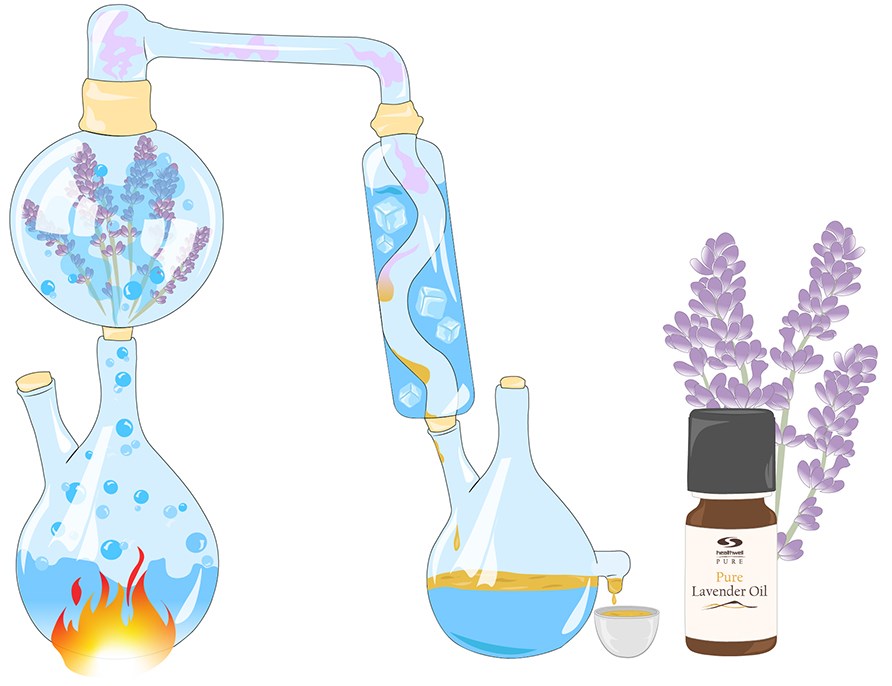Production of Essential Oils
Essential oils are mixtures of volatile, biologically active compounds produced from plants, usually by distillation or by squeezing the oil out of the shell. Read more about how the process of oil production works
- How are essential oils produced?
- Water or steam distillation
- Hydro distillation
- Cold pressing
Although essential oils are called oils, their molecular structure and consistency are very different from the vegetable oils we use such as jojoba oil or argan oil. The difference is that essential oils have a low fat content and are a type of volatile liquid with an extremely complex composition. They contain several hundred active substances that can affect both our body and mood.
How are essential oils produced?
In order for essential oils to have therapeutic and energizing effects in addition to a pleasant scent, they must be natural and of a high quality. Unfortunately, today there are many essential oils on the market that are not of a high quality, meaning many of the active ingredients are lost. In some cases, the essential oil may be mixed with a vegetable oil, meaning the concentration is not as high. In other cases, the production process can be carried out in such a way that the active ingredients are lost. In order for a plant extract to be called an essential oil, it must be extracted in one of the following ways: by distillation (which is the most commonly used method), by cold pressing or by direct heating of plant mass. Plant extracts that are extracted in other ways are not called essential oils.
Which method is best for producing essential oils? As mentioned, there are a few different ways to extract the volatile aromas from plants. Which method is most suitable depends on the plant material and the most effective way to obtain essential oils or aromas from that particular plant. There are many delicate plant parts and flowers, in which case water or steam distillation is best. There are also volatile oils that can only be obtained by being pressed out of the shell. Below you can read more about the most common methods.
Water or steam distillation
The most useful way to extract essential oils is by steam distillation. The process requires a lot of competence and knowledge because there are many variables such as time, temperature and type of distillation equipment. Some plants need to be distilled immediately after harvest, some are partially dried, and some may need to be completely dried before distillation. During steam distillation, the plant material is placed in a container above boiling water (distillation of water) or in a separate chamber through which vapours pass in an oxygen-free environment (steam distillation). The latter method is sometimes called dry distillation and takes place under pressure.
The advantage of these methods is that the plant parts do not come into contact with boiling water. The heat and steam break down the plant cells and withdraw the essential oils. Steam and essential oils are then transported through a cooling coil, where they are compressed and return to a liquid state, which consists of water and essential oil. Most essential oils will then float to the surface and the liquids will then separate. The water that remains after this process is called hydrosol and contains small amounts of essential oil and other water-soluble plant-based ingredients. The oil that is withdrawn becomes pure essential oil PURE essential oils are produced by steam distillation and the entire range can be found here - Healthwell PURE.
Production of essential oils by steam distillation:

Hydro-distillation
In this method, the plant material is immersed in water. The amount of water should be sufficient for the plant material to move freely in boiling water and avoid overheating. Water that is heated up quickly evaporates easily, and it may therefore be necessary to add water during the distillation process to prevent it from becoming unclean. The essential oil is then separated from the water in the same way as in steam distillation. Distillation with water is mostly used when the plant material is dense. Water distillation is a slower process compared to steam distillation and requires more work, more space, more fuel and even more water. In addition, some substances in the plant may deteriorate upon prolonged contact with boiling water, and some components may not be fully utilized in this way. Therefore, steam distillation is often a better method.
Expression or cold pressing
Another way of extracting essential oils is by cold pressing, a method only used in the case of citrus fruits. The peel of the citrus fruit contains small oil sacs, which are located just below the outer peel. By pressing the shell with your hand, you can get the oil out, but such a process would of course involve hard work and be inefficient. Therefore, the citrus oil is squeezed out with the help of efficient mechanical presses.
 (1).jpg)
Producing essential oils is not an easy process because each plant needs to be treated carefully and in its own way. Sometimes the living plant is used, in some cases the plant needs to be crushed beforehand, and some plants need to be dried. The water used is also important to take into account, as due to differences in water hardness/softness on, the temperature of the water needs to be exact and the distillation duration must be adjusted. Producing good quality essential oils therefore requires knowledge, patience, good raw materials and the right methods to extract the active ingredients in the best way. Read more about how to use essential oils, why essential oils are good for you, or get inspired by our recipes for DIY products using essential oils.

